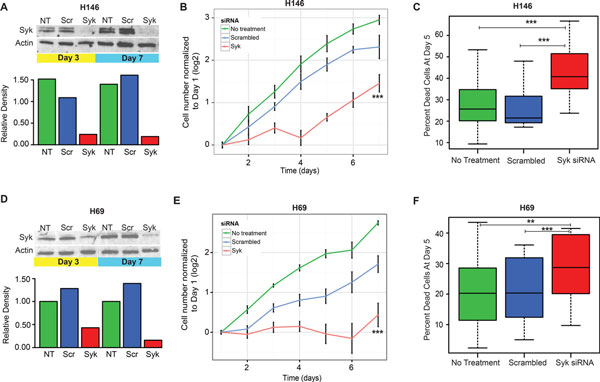Figure 6.

Effect of Syk knock-down in Syk/Fyn positive SCLC cell lines. The SCLC cell lines H146 (A-C) and H69 (D-F) were treated with Syk-specific and control siRNA as described in Materials and Methods section. (A, D) The efficiency of inhibition was measured by Western blotting on day 3 and 7 post transfection. Syk resolves as two bands, of which the lower is a less-functional splice variant that lacks 23 amino acids [37]. Band intensity (lower panels) was quantified by densitometry in ImageJ (http://rsbweb.nih.gov/ij/). (B, E) Cell proliferation, measured by cell counts as described in Materials and Methods section, shows that Syk-siRNA treatment induces statistically significant growth inhibition compared to untreated cells and to scrambled siRNA treatment. Asterisks denote overall statistical significance of slope as compared to control across the siRNA conditions, as follows: <0.0005 '***' 0.001 '**' 0.01 '*' 0.05 '.'. The viability growth curves (from N = 4 experiments) statistics were generated from slopes of a linear regression model. Multiple comparison of treatments were derived using ANOVA and Tukey's method [80]. (C and F) Percentage of dead cells (percent of ethidium homodimer positive cells normalized to total cell counts, see Materials and Methods) is significantly higher (H69 p-value < 2.2e-16; H146 p-value < 2.2e-16) in Syk siRNA treated cells at day 5, compared to controls. Asterisks denote statistical significance measured by paired t-test as compared to control across the siRNA conditions, as follows: <0.0005 '***' 0.001 '**' 0.01 '*' 0.05 '.'.
